Painted in oil on canvas, it is in line with the Mediterranean views which have made the reputation of several renowned artists, such as Vernet for this representation.
Through a carefully balanced composition, the work is imbued with a diverse narrative where light and detail come together to tell a story that is both elegant and captivating.
The figures in the foreground, the massive trees and the luminous sky are organized in theatrical harmony. The soft, golden light, typical of Vernet, accentuates the picturesque effect. Certain characteristics are specific to Vernet's paintings and recur regularly in his representations.
In the foreground, elegantly dressed figures are busy at the water's edge, illustrating for some a port activity and for others a typical social encounter of the time.
The characters in Vernet's works are always arranged in narrative groups, integrating a touch of elegance or everyday life, sometimes idealized.
The group is very regularly made up of elegantly dressed women sometimes wearing umbrellas, particularly pink ones, as is the case in his painting A View of Avignon, from the Right Bank of the Rhône Near Villeneuve sold for 6,231,346 euros in July 2013 at London
or his Mediterranean Harbor at Sunset with the Artist, His Daughter Emilie Chalgrin, His Son Carle Vernet, His Daughter-In-Law, Fanny Moreau, and His Servant Saint-Jean, on a Pier, a Lighthouse and a Natural Arch Beyond ( 1788) sold for 1,883,137 euros in January 2013 in New York.
We also find the very active little dog, as in several of his other paintings.
Such as Return from fishing in a Mediterranean port at sunset, a group of Orientals on the right (1780) sold for 630,000 euros on November 4, 2011 in Paris
or in A Grand View of the Sea Shore Enriched with Buildings, Shipping and Figures (1776) sold
5,134,264 euros in January of the same year, in New York,
A Mediterranean Port at Sunset, with a Fisherman in the Foreground and a Couple at Left Walking Along the Rocky Coast (1778), found a buyer for
559,473 euros in January 2019 also in New York
or the Le Soir/Clair de Lune (1752) sold for 2,106,440 euros in December 1999 in London.
Still three-quarters with his tail towards us, he seems to be observing the distant shore.
The background reveals a landscape bathed in light, with a sailing ship in calm waters, enriching the scene and evoking commerce and maritime adventure. Typical of Vernet's works, it presents itself slightly with its back to us, a large flag hanging from the stern and a thin, almost filamentary flag at the top of the highest mast, flying to the rhythm of the wind. We find these characteristics in the paintings cited above but also in other very large paintings, such as his
A Mediterranean Harbor at Sunset with Fisherfolk at the Water's Edge, a Lighthouse and a Man of War at Anchor in the Bay (1761) sold for 1,778,889 euros in January 2011 in New YorkOr his Mediterranean Harbor at Sunset with Fisherfolk and Merchants (1750) sold for 867,288 euros in April 2000 in London
On the left, on the other side of the bank, we can notice a building identifiable as the Château Borély, emblem of Marseille (current Museum of Decorative Arts of the city).
At that time, it was only a draft sketch by Charles Louis Clérisseau, French painter and architect (1721-1820).
Louis Borély, descendant of a rich trading family, commissioned Clérisseau to build the most beautiful bastide on the rural estate of Bonneveine, so that it would be recognized as a real castle.
After the representation of the castle by Clerisseau, it was too complex and was only executed with a few changes by the architect Camtadin Esprit Brun (1710-1804) under Louis-Joseph Denis, son of Louis Borély.
This detail is undoubtedly a deep imprint of the solid relationship between the artists and the high representatives of the time.
Indeed, the castle having only been built in 1767, Vernet's version of 1755 is witness to the esteem that Vernet must have aroused at the time, allowing him to have access to unpublished information. And maybe even influence some architects' ideas.
Nestled in the heart of the surrounding nature. this inclusion gives a precise geographical dimension to the work, which makes it valuable in the history of Marseille heritage.
The landscape here is more intimate with a gentle, less dramatized atmosphere than in pieces such as
“Clair de Lune” sold for 853,352 euros on December 6, 2017 in London.
It is even closer to certain large canvases whose golden light and vaporous clouds recall the moving skies that characterize Vernet's art, while adding a warm Mediterranean touch, such as his Mediterranean Harbor Scene at Sunset, with Fishermen ( 1765)
sold for 1,522,776 euros in July 2007 in London
Characteristic features which make our painting a work of high quality.
Of which we can also notice another characteristic that we also find in our painting.
The work is indeed distinguished by its finesse in the treatment of architectural and botanical details. Often characterized, as is the case in our painting, by trees in the foreground, with sinuous branches and delicate shade, framing the scene in a theatrical way, and rocks in the opposite, as if to invite the viewer to enter this enchanting world. This scenographic choice, which we find in many of Vernet's compositions, highlights his ability to construct rich and immersive visual spaces, often marked by architectural monuments in the background.
We can see this in His “Calm”/“Storm” (1773) sold for 3,406,025 euros in July 2023 in London and in many other paintings
or Ancient Temple on the Edge of a Shore at Setting Sun (1769)
sold for 1,544,000 euros in Paris in June 2007. And in many other paintings by the artist.
One of the most important features of our table is its duplicity.
To date, three paintings of this composition have been found.
One entitled “visit to the port” in a private collection is signed and dated lower left “joseph Vernet 1755 f.” (dimensions 87 x 136 cm). The latter is taken as a reference in the article by Emilie Beck Saiello (current Vernet expert) published in 2018 “between Paris and Marseille, Mediterranean shores. Some reflections on the Provencal relations of Joseph Vernet with the Phocaean Academy »
A second painting "idyllic view of a rocky Mediterranean bay", with identical composition, dimensions 72.5 x 98.5 cm, was put up for auction in Monaco in 1987 with an estimate of 400,000 FRF - 600,000 FRF (i.e. approximately 61,000 – 92,000 euros) Like ours it is, due to the quality, a workshop painting made in side and with Vernet.
Finally, the third painting, the one we present, is also an identical composition to that of Vernet with a few tiny differences.
As Emilie Beck Saiello mentions, "The painting (signed Vernet 1755) does not seem clearly identifiable among the commissions from the artist's book of reason, despite the presence of a character in red, quite characterized, in the foreground , which could correspond to the sponsor. (...) The quality of the work nevertheless makes it one of the most remarkable paintings of Vernet's stay in Provence. It also shows the appeal of the Phoenician landscape to amateurs and the prestige of the orders placed on the artist during his stay in Provence.
This painting is as much a characteristic demonstration of the quality of a Vernet as the educational role of the artist. Vernet, like many masters of the period, often produced an original version of a painting, which could then be reproduced or slightly modified by his workshop under his supervision, both to transmit his know-how and to meet growing demand. Mediterranean landscapes very fashionable in the 18th century.
It is likely that the first version of this composition, signed and dated in 1755, served as a direct model for the other two works. The quality of these paintings demonstrates the direct intervention of the master in certain key parts, notably the sky, the effects of light and the fineness of the details.
Particular attention is paid to light, which structures the space and gives remarkable depth. The vaporous skies and the reflections on the water are emblematic elements of Vernet whose quality we can see in our painting.
The choice of the subject as multiple representation is possibly due to the attention that Vernet paid to his stays in Marseille. According to Emilie Beck Saeillo, “This (large and diverse) clientele will continue to buy paintings from him after his departure. The views of the port of Marseille, exhibited in the city before being sent to Paris, aroused admiration for their quality and the modernity of their composition and experienced rapid artistic success. »
The first version of this painting being produced just after his departure from Marseille, it is the illustration of this fascination for the Mediterranean works of Vernet and the numerous commissions which resulted from it. The duplicity of this composition by our painting makes our painting a fascinating testimony to the working method of Joseph Vernet (and his workshop).
This importance is underlined in particular by the disappearance in our painting of the character "in red" facing us, at the back of the social group, which we find in the main painting which could, according to Emilie Beck Saeillo, be "the sponsor.” His disappearance in our painting confirms that the latter was surely commissioned by another sponsor, Vernet would therefore possibly have asked that this character no longer be among those represented.
The expert tells us
“All the artists who frequented him testify to this: Vernet was not stingy with advice and shared his address book quite generously. He certainly benefited the Academy of Marseille, its teachers and its students. He undoubtedly wrote a few letters of presentation (...) recommended the Phocaean Academy to amateurs likely to encourage the institution through a contribution or a gift. Vernet, and he was certainly fully aware of this, was also and above all, for the teachers and students of the Phocaean Academy, a model of social and professional success. »
These three paintings, perfectly similar in their composition but slightly distinct in their execution, embody the very essence of collective work within Joseph Vernet's workshop. They illustrate both the artistic authority of the master and the pedagogy towards his students.
These works, between the hands of the master and that of the apprentices, demonstrate a subtle balance between tradition, learning and artistic production.
As such, this painting magnificently illustrates the approach of Vernet and his workshop, combining romanticism, precision and homage to the Mediterranean and the Phocaean Academy.
It is a work both representative of its time and singularly poetic, where each element seems to tell a story while capturing the essence of landscape art.
It is a rich panorama of Vernet's art, where the local, the ideal and the narrative intertwine with virtuosity
Dimensions: H 71 cm x L 99 cm
with frame: H 85 x L 14 cm



























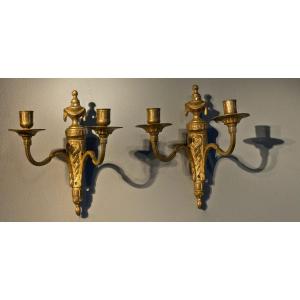










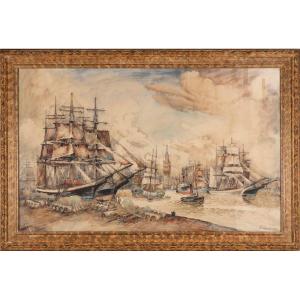




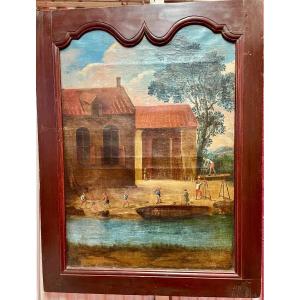

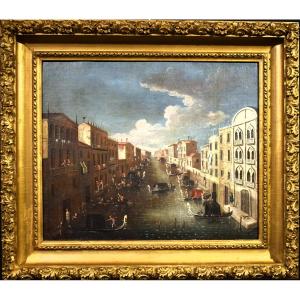
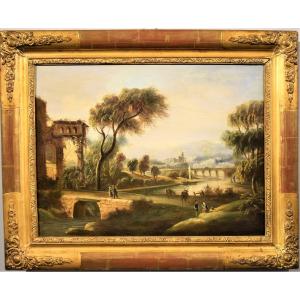



 Le Magazine de PROANTIC
Le Magazine de PROANTIC TRÉSORS Magazine
TRÉSORS Magazine Rivista Artiquariato
Rivista Artiquariato